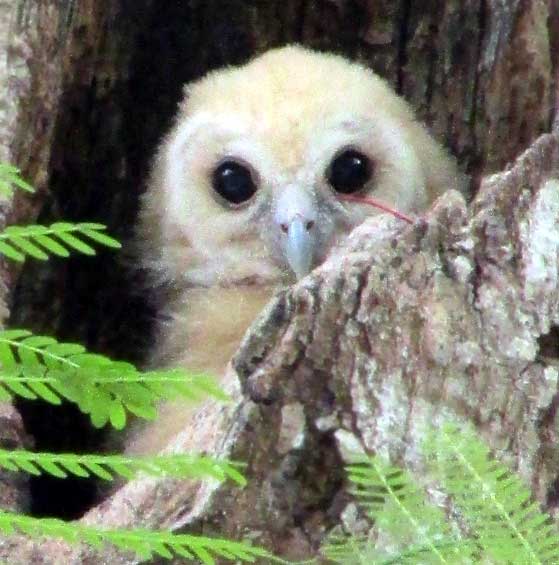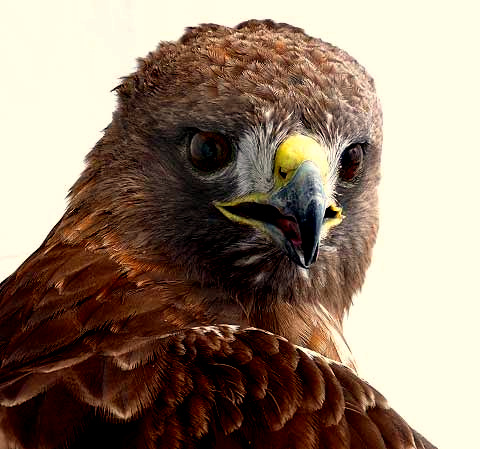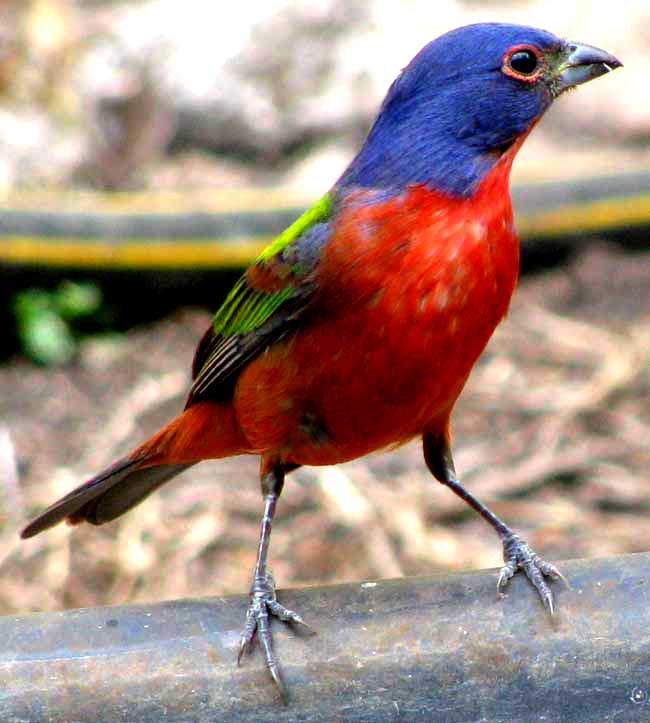
Eyes may be even more important to birds than to humans. One indication of this is that bird eyes are much larger, relative to total face area, than human eyes. The common European Starling's eyes account for fifteen percent of the mass of the bird's entire head, while human eyes amount to less than two percent. Surely the eyes of the nestling Mottled Owl, Strix virgata, shown at the right account for even more than fifteen percent.
 Anatomical diagram of bird eye; from 'The New International Encyclopædia, v.3. 1905, via Wikimedia Commons
Anatomical diagram of bird eye; from 'The New International Encyclopædia, v.3. 1905, via Wikimedia CommonsOf course, no one really knows what birds see, but we can make educated guesses after studying bird eye anatomy. For instance, as the drawing of a bird's eye at the left helps us to understand, light enters the eye's corona -- C. in the diagram -- and is focused through the lens (L.) deeper into the eyeball. In the diagram the comb-like object behind the lens is something human eyes don't have, the pecten or pecten oculi. It is a structure of blood vessels believed to both control the pH inside the eyeball, and nourish the retina (R.) forming a thin layer of tissue at the back of the eye. The retina receives the image passed through the eyeball, and reports its stimuli to the brain, by way of the optic nerve (No.).
The human retina has two kinds of light-receiving receptor cells: cone cells used for daylight vision and; rod cells used for low light levels. Bird retinas have three kinds:
- rods - black & white vision in dim light
- cones - color vision in bright light
- double cones - color vision
This enables birds to see more colors than humans. In fact they may be able to perceive ultraviolet or near-ultraviolet light, which humans cannot. Moreover, in terms of having sharp vision, here's an important point:
The denser the retina's cone cells, the sharper is the perceived image.
 Red-tailed Hawk, Buteo jamaicensis, immature, photo by Fred Kost of Texas
Red-tailed Hawk, Buteo jamaicensis, immature, photo by Fred Kost of TexasThe human eye has at most 200,000 cones per square millimeter, while House Sparrows have approximately twice that number. Hawks, who must spot small prey from the sky, possess about five times as many as humans! Songbirds and predators such as hawks are believed to have the sharpest vision among birds. They can see details at distances two to three times farther away than humans.
Some nocturnal birds such as owls and whippoorwills have a layer at the back of the eye called the tapetum lucidum that, like a mirror, reflects light back through the retina, making it more likely that light will strike sensory cells in the retina. As a result, birds with a tapetum lucidum see much better at night. The tapetum lucidum produces the "eyeshine" seen when you shine a flashlight into the eyes of a nocturnal bird or mammal, or take its picture with a flash.
It's been suggested that sharpness of vision may not even be the birds' main sight-advantage over humans. Rather, their advantage may lie in their brain's ability to capture at a glance a picture that a human eye would have to scan back and forth to see and understand. This is more a matter of brain circuitry than eye structure.

Bird vision isn't superior to human vision in every respect, however. The next time you see a bird taking a close look at something, notice how it turns its head sideways. This is because eyes in most bird species lie at the sides of their heads -- owls being an exception. Therefore, when most birds look closely at something, they use only one eye at a time, and must turn their heads. Their eyes aren't exactly opposite one another, so there's some binocular vision in front, at least at a distance. Still, the "anterior blind area" of most birds is problematic.
One problem is that most of what most birds see lacks the depth of field made possible by binocular vision. However, birds and their brains have ways of compensating for this problem. For example, when birds look at something while bobbing their heads up and down, if the object's perceived position changes a lot between bobs, it's close up, but if there's little or no change, it's far away.
This and other aspects of bird vision is an area of much research and growing understanding of how birds see. A technical overview of the matter is provided in a freely available online 2017 paper by Tyrrell and Fernández-Juricic entitled Avian binocular vision: It’s not just about what birds can see, it’s also about what they can’t.